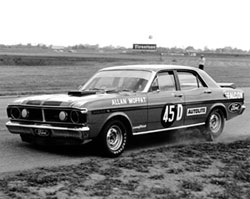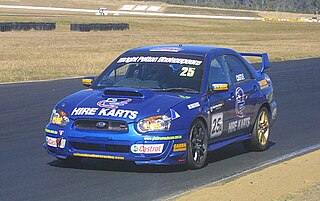
Australian Formula 2, sometimes abbreviated to AF2 or ANF2, is a "wings and slicks" formula racing category in Australia. The category is one of Australia's oldest, dating back to 1964. The current format of AF2 was introduced in 1978. Brian Shead of Cheetah Racing Cars and Garrie Cooper of Elfin Racing Cars were largely responsible for the development of the format, which was devised to suit the needs of Australian drivers, most of whom had little or no sponsorship and had to bear the costs of racing out of their own pockets.
The 1962 Australian Drivers' Championship was a CAMS sanctioned motor racing title for drivers of Formula Libre racing cars. The winner of the title, which was the sixth Australian Drivers' Championship, was awarded the 1962 CAMS Gold Star.
Australian Formula 3 has been the name applied to two distinctly different motor racing categories, separated by over twenty years.
The Australian One and a Half Litre Championship was a CAMS sanctioned national motor racing title contested annually from 1964 to 1968. It was open to drivers of cars complying with the Australian 1½ Litre Formula which specified open wheel racing cars fitted with unsupercharged engines using commercially available fuel and limited to 1500cc capacity. The title was staged over a single race in the first two years and over a series of races in the last three.

Australian Formula 1 (AF1) was a motor sport category for open-wheeler racing cars which was current in Australia from 1970 to 1983.

The Australian National Formula was an Australian motor racing category which was introduced by the Confederation of Australian Motor Sport in 1964 and remained current until the end of 1969. It replaced Formula Libre as the Australian premier racing formula.
The 1989 Australian Drivers' Championship was a motor racing competition open to drivers of racing cars complying with CAMS Formula Holden regulations. The championship winner was awarded the 1989 CAMS Gold Star as the Australian Drivers' Champion. It was the 33rd running of the Australian Drivers' Championship and the first to feature the Formula Holden class which had been developed during 1988, originally named Formula Australia.

The Australian Tourist Trophy is a Confederation of Australian Motor Sport-sanctioned national motor racing title, contested between 1956 and 1979 by Sports Cars and, since 2007, by GT cars. The trophy is currently awarded to the outright winners of the Bathurst 12 Hour.
The 1972 Australian Touring Car Championship was a CAMS sanctioned national motor racing title open to Improved Production Touring Cars and Group E Series Production Touring Cars. The championship, which was the 13th running of the Australian Touring Car Championship, began at Symmons Plains and ended at Oran Park after eight rounds.

Group E Series Production Touring Cars was an Australian motor racing category for production based sedans competing with limited modifications. It was current from 1964 to 1972.

Group 3E Series Production Cars is an Australian motor racing formula for production based cars competing with limited modifications. Group 3E cars formerly contested the Australian Manufacturers' Championship and Australian Production Car Championship titles and compete in the annual Bathurst 12 Hour and Bathurst 6 Hour endurance races.
The 1966 Australian Drivers' Championship was a CAMS sanctioned motor racing title for drivers of racing cars complying with either the Australian National Formula or the Australian 1½ Litre Formula. The winner of the title, which was the tenth Australian Drivers' Championship, was awarded the 1966 CAMS Gold Star.
The 1968 Australian One and a Half Litre Championship was a CAMS sanctioned motor racing title for drivers of Australian 1½ Litre Formula racing cars. It was the fifth and final Australian One and a Half Litre Championship to be awarded prior to the demise of the formula at the end of 1968.
The 1964 Australian One and a Half Litre Championship was a CAMS sanctioned motor racing title for drivers of Australian 1½ Litre Formula racing cars. The title was contested over a 34 lap, 76½ miles (123 km) race held at the Warwick Farm circuit in New South Wales, Australia on 6 September 1964. This was the first national title for the Australian 1½ Litre Formula which was in its first year of existence.
The 1996 Australian Formula Ford Championship was a CAMS sanctioned motor racing title for drivers of Formula Ford racing cars. It was the 27th national series for Formula Fords to be held in Australia and the 4th to be sanctioned as an Australian Formula Ford Championship. The series was promoted as the 1996 Ford Racing Slick 50 Australian Formula Ford Championship.
The 1965 Australian Drivers' Championship was a CAMS sanctioned Australian national motor racing title open to racing cars complying with the Australian National Formula or the Australian 1½ Litre Formula. The title was contested over a six race series with the winner awarded the 1965 CAMS Gold Star. It was the ninth Australian Drivers' Championship.
The 1968 Australian Drivers' Championship was a CAMS-sanctioned national motor racing title open to racing cars complying with the Australian National Formula or the Australian 1½ Litre Formula. The title was contested over a six-race series, with the winner awarded the 1968 CAMS Gold Star.
The 1971 Australian Drivers’ Championship was a CAMS sanctioned motor racing title open to Australian Formula 1 and Australian Formula 2 racing cars. It was the fifteenth Australian Drivers' Championship and the first to feature cars complying with a new for 1971 Australian Formula 1 which permitted cars with production based V8 engines of up to 5 litre capacity or racing engines of up to eight cylinders and up to 2 litre capacity. The championship winner was awarded the 1971 CAMS Gold Star.
The 1967 Australian One and a Half Litre Championship was a CAMS sanctioned Australian motor racing title for racing cars complying with the Australian 1½ Litre Formula. The title, which was the fourth Australian One and a Half Litre Championship, was won by Max Stewart, driving a Rennmax BN1 Ford.
Alec Mildren (1915–1998) was active in Australian motor racing as a driver from 1938 to 1961, and subsequently as the owner of Alec Mildren Racing.





